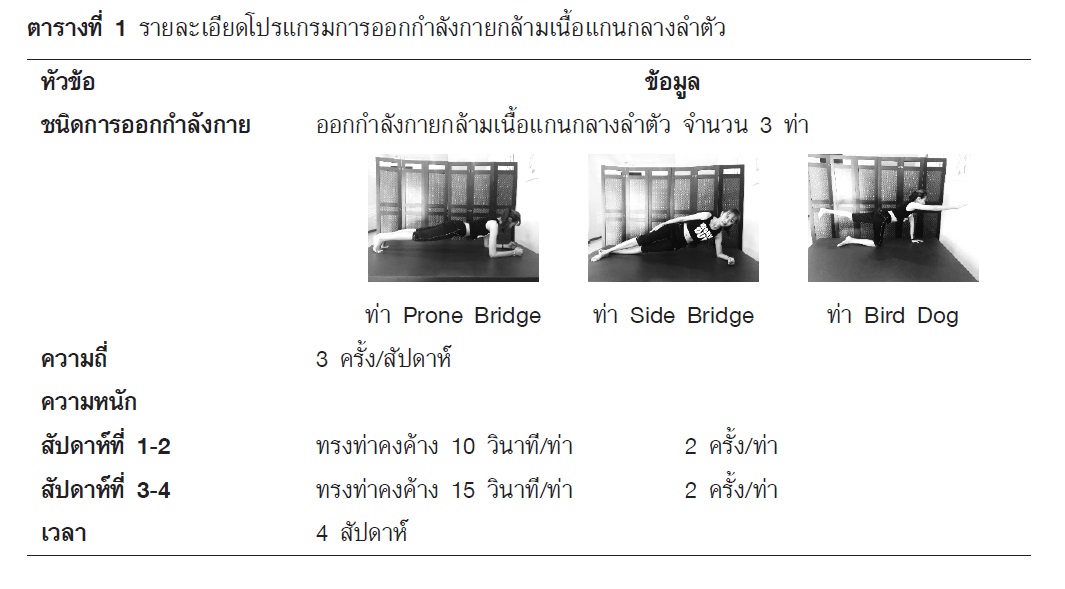EFEECTS OF CORE MUSCLE TRAINING ON ABDOMINAL MUSCLE STRENGTH AND ENDURANCE AND SIT-TO-STAND IN OBESE MALE ADOLESCENCE : A PILOT STUDY
Main Article Content
Abstract
Purpose : This pilot study aimed to examine the effect of a 4-week core muscle training on muscle performance among obese adolescents.
Methods : Ten obese male adolescents, aged between 16-18 years were randomly assigned to either the exercise group (n=5) or the control group (n=5). Exercise protocol consisted of a prone bridge, a side bridges and a bird dog. The exercise group performed core exercise program 3 times a week, for 4 consecutive weeks, while the control group continued their normal daily activities and did not participated in core muscle training. Sit-to-stand test and sit up test were used to assessed muscle performance at baseline and after an exercise program.
Results : After 4 weeks of exercise, the exercise group showed an improvement in muscle strength and compared to the control group. Time during five times sit-to-stand test decreased the number of test while sit up repetitions increased compared with baseline and the control (p<0.05).
Conclusion : These results suggest that core exercise program might be used as an adjust exercise to improve muscle performance associated with sit-to-stand function among adolescence.
Article Details
References
สถาบันวิจัยระบบสาธารณสุข โดย วิชัย เอกพลากร, ลัดดา เหมาะสุวรรณ, นิชรา เรืองดารกานนท์, วราภรณ์ เสถียรนพเกล้า, หทัยชนก พรรคเจริญ รายงานการสำารวจสุขภาพประชาชนไทยโดยการตรวจร่างกายสุขภาพเด็ก ครั้งที่ 5 พ.ศ. 2557. (online). วันที่ทำการสืบค้น 9 กรกฎาคม 2562, https://www.hiso.or.th/hiso5/report/report2014kid.php
American College of Sports Medicine. (2013). ACSM’s guidelines for exercise testing and prescription. Lippincott Williams & Wilkins.
Chamnongkich S, Wongsaya E & Pratanaphon S. (2013). Trunk displacement during the Sit-to-stand test in young adults. Bulletin of Chiang Mai Associated Medical Sciences, 46(2): 131-140
Cole, T. J., Bellizzi, M. C., Flegal, K. M., & Dietz, W. H. (2000). Establishing a standard definition for child overweight and obesity worldwide: international survey. British Medical Journal, 320(7244), 1240-1243. doi: 10.1136/bmj.320.7244.1240
Csuka, M., & McCarty, D. J. (1985). Simple method for measurement of lower extremity muscle strength. The American Journal of Medicine, 78(1), 77-81. doi: 10.1016/0002-9343(85)90465-6
Dello Iacono, A., Padulo, J., & Ayalon, M. (2016). Core stability training on lower limb balance strength. [Randomized Controlled Trial]. Journal of Sports Science and Technology. 34(7), 671-678. doi: 10.1080/ 02640414.2015.1068437
Ervin, R. B., Fryar, C. D., Wang, C. Y., Miller, I. M., & Ogden, C. L. (2014). Strength and body weight in US children and adolescents. Pediatrics, 134(3), e782-789. doi: 10.1542/peds.2014-0794
Hasan, N. A. K., Kamal H. M. and Hussein Z. A. (2016). Relation between body mass index percentile and muscle strength and endurance. Egyptian Journal of Medical Human Genetics, 17(4): 367-372.
Hibbs, A. E., Thompson, K. G., French, D., Wrigley, A., & Spears, I. (2008). Optimizing performance by improving core stability and core strength. Journal of Sports Medicine, 38(12), 995-1008. doi: 10.2165/ 00007256-200838120-00004
Hulens, Vansant, G., Lysens, R., Claessens, A. L., Muls, E. and Brumagne, S. (2001). Study of differences in peripheral muscle strength of lean versus obese women: an allometric approach. International Journal of Obesity and Related Metabolic Disorders, 25(5): 676-681.
Kibler, W. B., Press, J., & Sciascia, A. (2006). The role of core stability in athletic function. Sports Medicine, 36(3), 189-198. doi: 10.2165/00007256-200636030-00001
Nunez-Gaunaurd, A., Moore, J. G., Roach, K. E., Miller, T. L., & Kirk-Sanchez, N. J. (2013). Motor proficiency, strength, endurance, and physical activity among middle school children who are healthy, overweight, and obese. Pediatric Physical Therapy, 25(2), 130-138; discussion 139. doi: 10.1097/ PEP.0b013e318287caa3
Okada, T., Huxel, K. C., & Nesser, T. W. (2011). Relationship between core stability, functional movement, and performance. [Randomized Controlled Trial]. The Journal of Strength and Conditioning Research, 25(1), 252-261. doi: 10.1519/JSC.0b013e 3181b22b3e.
Prakanta, P. and Pratanaphon, S. (2012). Comparisons in physical fitness between obese, overweight and normal weight children aged 6-12 years old. Journal of Associated Medical Sciences, 45(3): 49-58.
Pongprapai, S., Mo-suwan, L., & Leelasamran, W. (1994). Physical fitness in obese school children in Hat Yai, Southern Thailand. The Southeast Asian Journal of Tropical Medicine and Public Health, 25, 354-354.
Rahmat A., Naser H., Belal M. and Hasan D. (2014). The effect of core stabilization exercises on the physical fitness in children 9-12 years. Sports Science Society of Roman, 10(3): 2401
Samokham, N., & Sitilertpisan, P. (2016). Effect of dynamic core stability exercise on physical performance in male dragon boat paddlers. Journal of Associated Medical Sciences, 49(1), 146-146.
Sasaki, S., Nagano, Y., Kaneko, S., Sakurai, T., & Fukubayashi, T. (2011). The Relationship between Performance and Trunk Movement During Change of Direction. Journal of Sports Science and Medicine, 10(1), 112-118.
Sarah, J., Gribbin, T. C., Lisman, P., Murphy, K., & Deuster, P. A. (2017). Systematic review of the association between physical fitness and musculoskeletal injury risk: Part 2— Muscular endurance and muscular strength. The Journal of Strength & Conditioning Research, 31(11), 3218-3234.
Schilling J. F., Murphy J. C., Bonney J. R., & Thich J. L. Effect of core strength and endurance training on performance in college students: randomized pilot study. Journal of Bodywork and Movement Therapies. 2013 Jul;17(3):278-90. doi: 10. 1016/j.jbmt.2012.08.008. Epub 2012 Sep 15. PMID: 23768270.
Thivel, D., Ring-Dimitriou, S., Weghuber, D., Frelut, M. L., & O’Malley, G. (2016). Muscle Strength and Fitness in Pediatric Obesity: a Systematic Review from the European Childhood Obesity Group. [ReviewSystematic Review]. Obesity Facts, 9(1), 52-63. doi: 10.1159/000443687
Whitney, S. L., Wrisley, D. M., Marchetti, G. F., Gee, M. A., Redfern, M. S., & Furman, J. M. (2005). Clinical measurement of sit-to-stand performance in people with balance disorders: validity of data for the Five-Times-Sit-to-Stand Test. Physical Therapy, 85(10), 1034-1045.
World Health Organization: Childhood overweight and obesity 2014. (Online). Retrieved January 24, 2017, from World Health Organization Website: www.who.int/diet physicalactivity/childhood
Xu, X., Mirka, G. A., & Hsiang, S. M. (2008). The effects of obesity on lifting performance. Applied Ergonomics, 39(1), 93-98. doi: 10.1016/j.apergo.2007.02.001
Zalesin, K. C., Franklin, B. A., Miller, W. M., Peterson, E. D., & McCullough, P. A. (2011). Impact of obesity on cardiovascular disease. [Review]. Medical Clinics of North America, 95(5), 919-937. doi: 10.1016/j.mcna. 2011.06.005


